For a part of the market long written off for dead, there’s been a lot of action in the midsize pickup segment lately, and that’s great news for consumers who aren’t ready or willing to make the jump to a full-size truck.
We’ve seen General Motors return to market with two midsize models, the Chevrolet Colorado and GMC Canyon, while Toyota recently upgraded the Tacoma. Now comes Honda, returning to market after a two year absence with an all-new version of the midsize Ridgeline.
The original Honda Ridgeline generated plenty of buzz, opting for a car-like unibody platform rather than the traditional body-on-frame design. Despite initially solid reviews and strong sales following its 2005 debut, demand for the Ridgeline soon fell into a black hole leading the Japanese maker to pull it off the market in 2014. Now, Honda officials insist, they have “listened, learned and responded,” with a new truck that addresses the original Ridgeline’s weaknesses.
Among other things, they boast, they’ve given the 2017 Ridgeline or more solid, truck-like appearance, even while enhancing its car-like ride and handling. They’ve boosted its fuel economy without sacrificing towing or payload capacity. And they’ve updated the truck’s technology with an improved infotainment system and lots of new, high-tech safety gear.
To see if the 2017 Honda Ridgeline lives up to expectations, we headed to San Antonio, for two days of on- and off-road driving through Texas Hill Country. While we’re looking forward to spending still more time in the new truck, our initial impression was quite positive, the new model largely living up to Honda’s boasts with only a few notable concerns.
What’s intriguing about the midsize truck segment is how much it has changed about years of stagnation. There was a time, not that many decades ago, when midsize and compact pickups actually outsold full-size models. The equation reversed and a number of manufacturers walked away from the segment. The few who remained let their trucks age with little new to offer.
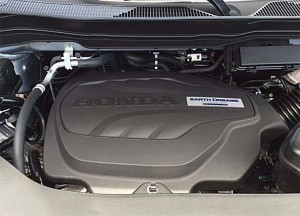
The 2017 Honda Ridgeline pairs a 3.5-liter V-6 with a 6-speed automatic, FWD and AWD both available.
Suddenly, we’re seeing a flood of new and update offerings – with more to come, including an updated Nissan Frontier and an all-new Ford Ranger. Of the three redesigned models now on the market, each targets a distinct niche, something we rarely see. The Toyota Tacoma is largely geared to those who want a serious off-roader. GM’s Colorado and Canyon are more car-like but still rely on a classic, body-on-frame platform suitable for those who want a serious work truck.
(Click Here to check out Toyota’s off-roading Tacome TRD Pro.)
As with the first-generation truck, the 2017 Honda Ridgeline continues to take aim at those likely moving out of passenger cars and crossover utility vehicles. They’re looking for an alternative that offers more truck-like capabilities. But don’t expect to see many Ridgelines at a worksite. This is a personal use pickup, not a fleet truck.
That said, Honda designers clearly responded to criticism of the original truck’s quirky design. The 2017 Ridgeline is a far more conservative design, notably abandoning the flying buttresses that tied together cab and bed on the original model. That was more than just a signature design cue. It actually held the first truck together. So, Honda had to come up with some creative engineering solutions to make up for the loss of that structural element.
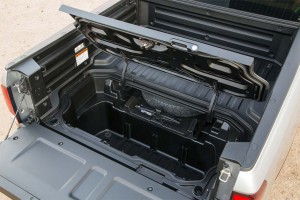
A large "trunk" is hidden under the Ridgeline's cargo floor, making it especially suitable for tailgating.
Among other things, the new Ridgeline makes use of far more ultra-high-strength steel than the original. That translates into not only a stiffer body, but one that Honda now expects to deliver a full five-star crash rating from the National Highway Traffic Safety Administration, while it anticipates winning a Top Safety Pick-Plus endorsement from the Insurance Institute for Highway Safety.
The 2017 Ridgeline’s silhouette may be a bit more traditional but the nose picks up some of the design cues we’re seeing on other recent Honda passenger cars and utility vehicles, such as the horizontal grille, here framed by LED running lights. Surprisingly, Honda designers were able to work in some neat aerodynamic tricks to deliver the lowest drag coefficient, 0.31, in the midsize truck market.
That’s one of the reasons why the new model achieves best-in-class fuel economy (excluding the diesel offerings from GM), at up to 26 miles per gallon on the highway.
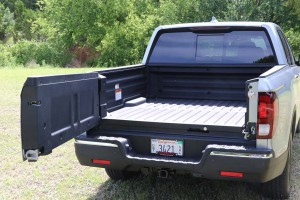
The Ridgeline's Dual Action Tailgate can swing open like a door, or fold flat like a regular tailgate.
As for the bed, it’s designed to carry up to around 1,500 of cargo – the Ridgeline also capable of towing up to 5,000 pounds.
You can access cargo by either flipping the Dual-Action Tailgate down, or letting it swing open – the only truck to offer that feature. You’ll also find more than enough width between the wheel arches to lay flat a 4×8 sheet of plasterboard or plywood. The rear part of the bed lifts up, meanwhile, to reveal a hidden trunk large enough to hold an 82-quart cooler, one reason Honda is billing the Ridgeline as the ultimate tailgating truck.
The one downside is that the bed isn’t quite as deep as that offered by some of its competitors.
Among the trick features Honda is offering with the 2017 Ridgeline, you can order a tailgate speaker system. Rather than build easy-to-damage speakers into the bed, however, Honda actually came up with a novel approach, mounting multiple “exciters” behind the bed panels. There are similar to the magnets on a conventional speaker and, in fact, make those panels actually function as if they were speaker cones. While not up to audiophile quality, the sound is readily acceptable for a tailgate party.
For a party, you’ll also find a 400-watt 120-volt AC plug in the bed.
Nose to tail, the new Ridgeline measures 210 inches, three more than the original model. The wheelbase grows an equal amount, to 125 inches.
As a result, the Ridgeline proves to be surprisingly roomy, front and back. It may be deemed a “midsize,” but it offers nearly full-size interior space. And you’ll find that the relatively spartan cabin of the original has been markedly upgraded, featuring far more upscale materials and finishes. There are plenty of storage nooks, including large spaces beneath both front and rear seats – the back seats even folding up, providing enough room to load in an adult’s bicycle without removing either wheel.
The cabin features an assortment of high tech touches, including a much newer infotainment system than the original Honda Ridgeline. It’s feature-packed, with options like 4G LTE WiFi and both Apple CarPlay and Android Auto. We’d love to love it but the truth is the screen on the top-line, 8-inch package is cheap looking and the touch interface can be difficult to use. Honda, please bring back volume and tuning knobs. Bouncing around on rough roads, it’s extremely difficult to use.
The new Ridgeline also features a number of digital safety systems, including the Honda Sensing package that includes such things as blind spot detection, active cruise control and lane keep, the latter nudging you back into your lane if you inadvertently drift across the line.
If you had X-ray vision you’d discover the underpinnings of the 2017 Honda Ridgeline are vastly different from competing trucks. The unibody construction is paired with a multilink rear suspension that’s designed to give the new truck a lot more car-like ride, even on dirt roads. As we discovered during an off-road exercise, it all but floated over a series of railroad ties. Driving the same path in the Tacoma and Colorado was a far more torturous experience.
On road, in fact, one might almost forget the fact that you’re driving a pickup. The added height and mass are far less apparent than in competing, body-on-frame trucks, though don’t expect the Ridgeline to handle like a sports car.
Meanwhile, steps taken to improve noise clearly pay off. Even with one’s foot pressing the throttle down to the floorboards, the Ridgeline proved surprisingly quiet inside.
The new Ridgeline is offered with just one engine, a 3.5-liter i-VTEC V-6 making 280 horsepower and 262 pound-feet of torque. (The first-generation truck churned out 250 hp and 247 lb-ft.) The engine is paired with a 6-speed automatic and now is available in both front-drive and all-wheel-drive configurations. Honda is betting it can tap broader demand in warm climes like California with the slightly cheaper FWD version.
The AWD package nominally sends 100% of the torque, under ideal conditions, to the front wheels. If it needs to spread traction out, it not only can shift power to the rear but vector up to 100% of that torque to one back wheel or the other. That helps to actually steer you through a corner.
As we noted earlier, the new 2017 Honda Ridgeline will deliver 19 mpg in the city, 26 on the highway – as much as 6 mpg better than the old model. The all-wheel-drive model will trim a single mpg off those numbers, to 18 and 25.
(For more on the new Ridgeline’s features and fuel economy, Click Here.)
As for pricing, the base 2017 Honda Ridgeline in RT trim starts at $29,475 – plus $900 in delivery fees – in front-drive mode; the all-wheel package bumping that to $31,275. The top-line Ridgeline RTL-E Black package will set you back $42,870.
It’s hard to dispute that Honda has made some major improvements in the new 2017 Ridgeline. The pickup is both truck solid and capable, yet it also has the smooth ride and handling, as well as the refinement and features, you’d expect in a passenger car.
Some potential buyers may still find it difficult to get their head around the idea of a unibody pickup. But we expect lots of others will be just fine with the concept and attracted to the new Honda Ridgeline’s many segment-leading features. It’s not for everyone, but as the midsize pickup segment regains some of its former luster, Honda is all but certain to find a receptive market.
(Trucks rule as buyers shift out of sedans and coupes. Click Here for more.)


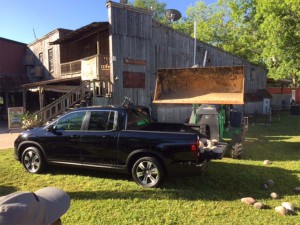
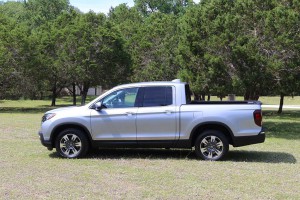
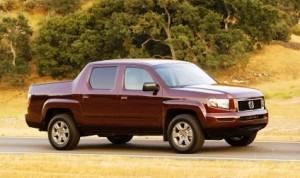
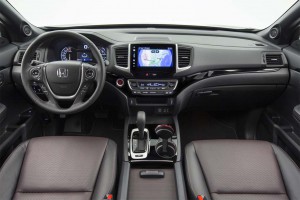
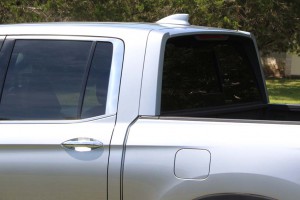
Any indications that the original Ridgeline suffered from structural issues? That was certainly true of the 80’s VW Sporttruck. Contractors were treating them like their other pickups and they didn’t hold up, they folded up.
No indication of serious trouble that I have heard, Dave. Honda over-built the original Ridgeline (hence the flying buttresses). We’ll see if the new design holds as well.
Paul E.
A “Unibody Pickup”… where have I heard that before?
Getting the spare tire out of hole in the bed will give an old man a heart attack.
I just get a real truck instead.. Sorry Honda.